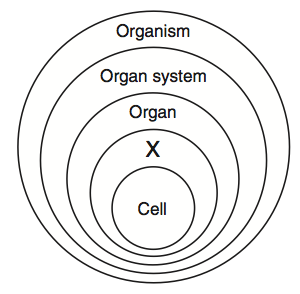Human Body Systems
Links
The Incredible Human Machine Video Skin Interactive Skin - Know more!
Integumentary System Jeopardy
The Integumentary System is the organ system that protects the body from damage, comprising the skin and its appendages (including hair, scales, feathers, hoofs, and nails).
Functions
Layers

The major cell of the epidermis is the keratinocyte, which produces keratin. Keratin is a fibrous protein that aids in protection. Keratin is also a water-proofing protein. Millions of dead keratinocytes rub off daily. The majority of the skin on the body is keratinized, meaning waterproofed. The only skin on the body that is non-keratinized is the lining of skin on the inside of the mouth.
The color of human skin depends on the amount of pigment melanin that the body produces. Small amounts of melanin result in light skin while large amounts result in dark skin.
Hair

The Homunculus Man (How your brain represents skin)The most sensory rich areas of the body are the
hands, feet, and facial structures.

This is how the your body sensory mechanism is represented in the brain

Links
The Incredible Human Machine Video Skin Interactive Skin - Know more!
Integumentary System Jeopardy
The Integumentary System is the organ system that protects the body from damage, comprising the skin and its appendages (including hair, scales, feathers, hoofs, and nails).
Skin is 15% of your total body weight.
Functions
- Protection
- Sensory Response (nerve cells relay information to the brain)
- Formation of Vitamin D (produced with ultraviolet light in epidermis)
- Regulates body temperature (blood vessels in the skin can hold or release heat, sweat glands remove heat cooling the skin)
- Gets rid of waste (sweat glands release water, salt, and other waste products)
Layers
- Epidermis - outermost layer of the skin composed of squamous cells. This layer is characterized into two distinct types: thick skin and thin skin.
- Dermis - thickest layer of skin that lies beneath and supports the epidermis.
- Hypodermis (Subcutis) - innermost layer of the skin that helps to insulate the body and cushion internal organs.
The major cell of the epidermis is the keratinocyte, which produces keratin. Keratin is a fibrous protein that aids in protection. Keratin is also a water-proofing protein. Millions of dead keratinocytes rub off daily. The majority of the skin on the body is keratinized, meaning waterproofed. The only skin on the body that is non-keratinized is the lining of skin on the inside of the mouth.
The color of human skin depends on the amount of pigment melanin that the body produces. Small amounts of melanin result in light skin while large amounts result in dark skin.
Hair
¡Made from epidermis
¡Hair à mostly dead, keratin-filled cells
¡Each hair grows for several years
¡Hair color based on amount of melanin
§Blonde, red hair has less than brown, black
Nails
¡Made by specialized epidermal cells located in light, semicircular area at base of nail
¡Become filled with keratin as they get pushed forward
¡Continue to grow throughout life
Fun Facts about Skin
¡ A large amount of the dust in you home is actually dead skin
¡ Although polar bears have both white and transparent (see through) fur, their skin is actually black.
¡ Amphibians such as frogs have unique skin. Rather than drinking water, frogs actually soak it into their body through their skin. They also use their skin to absorb around half the air they need.
Summary
The Homunculus Man (How your brain represents skin)The most sensory rich areas of the body are the
hands, feet, and facial structures.
This is how the your body sensory mechanism is represented in the brain
Lesson Review
1.
What are the 5 functions of the integumentary
system? Answer in complete sentences
2.
What is the outer layer of the skin?
a. Dermis
b. Collagen
c. Subcutaneous
d. Epidermis
3. Which of the following is NOT a part of the
integumentary system?
a. skin
b. hair
c. cartilage
d. nails
4. What does the color of human skin depend on?
a. genetics
b. melanin
c. sun exposure
d. all of the above
5. How does sweat maintain homeostasis within the human body? Answer in 2 complete sentences
6. What is the majority of dust in your house made from? Answer in 1 complete sentence





